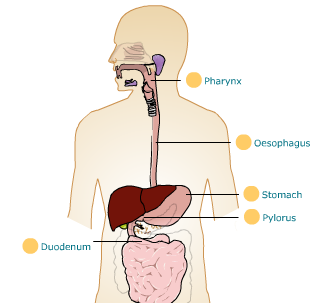
The journey to the stomach
The oesophagus is a muscular tube about 25 cm long which connects the pharynx to the stomach. During swallowing, food is moved through the oesophagus by peristalsis - a wave of muscle contractions that passes down the tube.
The stomach is a muscular sac that acts as a reservoir for food. It enlarges when a meal is eaten. In the stomach, digestive enzymes and hydrochloric acid, secreted by glands in the stomach wall, are added to the food.
Contraction and relaxation of the muscular walls of the stomach churn up the food and convert it into a semi-liquid called chyme.
At intervals, small amounts of chyme are pumped out of the stomach through the pylorus - the exit of the stomach - into the entrance of the duodenum. The pyloric sphincter - a ring of muscle that can close the pylorus - prevents chyme flowing back into the stomach from the duodenum.
